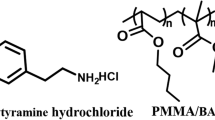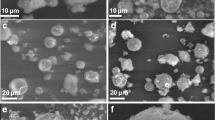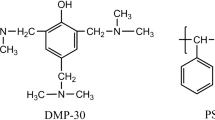Abstract
In this study, the pyraclostrobin@polydopamine-polyurea microcapsules (Pyr@PNPMC) with anti-photolysis and sustained-release properties were prepared by interfacial polymerization based on O/W Pickering emulsion templates. The effects of water–oil ratio, stirring speed, temperature, and polydopamine nanoparticles (PDANPs) content on the preparation of microcapsules were systematically investigated. Under this condition, the encapsulation efficiency of microcapsules could reach up to 77.7%. Fourier transform infrared spectroscopy (FTIR) and scanning electron microscopy (SEM) images indicated that Pyr@PNPMC were prepared successfully, and the microcapsules were a regular sphere with a large number of PDANPs attached to the dense inner layer. According to the results of sustained-release and anti-photolysis experiments, the release rate of Pyr@PNPMC was slightly faster than that of the pyraclostrobin@polyurea microcapsules (Pyr@MC). Under UV light exposure for 7 h, Pyr@PNPMC still retains 83% of the active ingredient, while for Pyr@MC nearly 75% of the active ingredient had been lost.











Similar content being viewed by others

References
Patel JS, Gudmestad NC, Meinhardt S, Adhikari TB (2012) Pyraclostrobin sensitivity of baseline and fungicide exposed isolates of Pyrenophora tritici-repentis. Crop Prot 34:37–41. https://doi.org/10.1016/j.cropro.2011.10.015
Yin YN, Kim YK, Xiao CL (2012) Molecular characterization of pyraclostrobin resistance and structural diversity of the cytochrome b Gene in Botrytis cinerea from Apple. Phytopathology 102(3):315–322. https://doi.org/10.1094/phyto-08-11-0234
Myresiotis CK, Bardas GA, Karaoglanidis GS (2008) Baseline sensitivity of Botrytis cinerea to pyraclostrobin and boscalid and control of anilinopyrimidine- and benzimidazole-resistant strains by these fungicides. Plant Dis 92(10):1427–1431. https://doi.org/10.1094/pdis-92-10-1427
Liu X, Wu H, Hu T, Chen X, Ding X (2018) Adsorption and leaching of novel fungicide pyraoxystrobin on soils by C-14 tracing method. Environ Monit Assess 190(2).https://doi.org/10.1007/s10661-017-6458-5
Yang T, Xu C, Liu X, Chen X, Zhang J, Ding X (2014) Fate of a novel strobilurin fungicide pyraoxystrobin in flooded soil. Environ Sci Process Impacts 16(6):1495–1500. https://doi.org/10.1039/c3em00706e
Gajbhiye VT, Gupta S, Mukherjee I, Singh SB, Singh N, Dureja P, Kumar Y (2011) Persistence of Azoxystrobin in/on Grapes and Soil in Different Grapes Growing Areas of India. Bull Environ Contam Toxicol 86(1):90–94. https://doi.org/10.1007/s00128-010-0170-2
Zeng LR, Shi LH, Meng XG, Xu J, Jia GF, Gui T, Hu DY (2019) Evaluation of photolysis and hydrolysis of pyraclostrobin in aqueous solutions and its degradation products in paddy water. J Environ Sci Health B 54(4):317–325. https://doi.org/10.1080/03601234.2019.1571360
Dubey R, Shami TC, Rao KUB (2009) Microencapsulation Technology and Applications. Def Sci J 59(1):82–95. Retrieved from <Go to ISI>://WOS:000263594800012
Wong CY, Al-Salami H, Dass CR (2018) Microparticles, microcapsules and microspheres: A review of recent developments and prospects for oral delivery of insulin. Int J Pharm 537(1–2):223–244. https://doi.org/10.1016/j.ijpharm.2017.12.036
Urbas R, Milosevic R, Kasikovic N, Pavlovic Z, Elesini US (2017) Microcapsules application in graphic arts industry: a review on the state-of-the-art. Iran Polym J 26(7):541–561. https://doi.org/10.1007/s13726-017-0541-1
Sopena F, Maqueda C, Morillo E (2009) Controlled release formulations of herbicides based on micro-encapsulation. Cienc Investig Agrar 36(1):27–42. Retrieved from <Go to ISI>://WOS:000265273500002
Brown EN, Kessler MR, Sottos NR, White SR (2003) In situ poly(urea-formaldehyde) microencapsulation of dicyclopentadiene. J Microencapsul 20(6):719–730. https://doi.org/10.1080/0265204031000154160
Perignon C, Ongmayeb G, Neufeld R, Frere Y, Poncelet D (2015) Microencapsulation by interfacial polymerisation: membrane formation and structure. J Microencapsul 32(1):1–15. https://doi.org/10.3109/02652048.2014.950711
Jang IB, Sung JH, Choi HJ (2005) Synthesis of microcapsule containing oil phase via in-situ polymerization. J Mater Sci 40(4):1031–1033. https://doi.org/10.1007/s10853-005-6527-y
Zhao Y, Zhang W, Liao L, Li W, Xin Y (2011) Preparation Process of Microcapsule Containing Phase Change Material for Thermal-Energy Storage. Adv Sci Lett 4(3):933–937. https://doi.org/10.1166/asl.2011.1350
Onder E, Sarier N, Cimen E (2008) Encapsulation of phase change materials by complex coacervation to improve thermal performances of woven fabrics. Thermochim Acta 467(1–2):63–72. https://doi.org/10.1016/j.tca.2007.11.007
Ying DY, Phoon MC, Sanguansri L, Weerakkody R, Burgar I, Augustin MA (2010) Microencapsulated Lactobacillus rhamnosus GG Powders: Relationship of Powder Physical Properties to Probiotic Survival during Storage. J Food Sci 75(9):E588–E595. https://doi.org/10.1111/j.1750-3841.2010.01838.x
Kwon JY, Kim HD (2006) Preparation and application of polyurethane-urea microcapsules containing phase change materials. Fibers and Polymers 7(1):12–19. https://doi.org/10.1007/bf02933596
Li D, Wang Y, Wang J, Liu H (2019) Effect on the characterization of metolachlor polyurea microcapsules with urea instead of polyamines. Des Monomers Polym 22(1):140–149. https://doi.org/10.1080/15685551.2019.1653031
Suzuki S, Kondo T, Mason GS (1968) Studies on microcapsules. I. Preparation of polyerethane and polyphenolester microcapsules. Chem Pharm Bull 16(8):1629–1631. Retrieved from <Go to ISI>://MEDLINE:5708258
Shiba M, Tomioka S, Koishi M, Kondo T (1970) Studies on microcapsules. V. Preparation of polyamide microcapsules containing aqueous protein solution. Chem Pharm Bull 18(4):803–809. Retrieved from <Go to ISI>://MEDLINE:5429164
Cosco S, Ambrogi V, Musto P, Carfagna C (2006) Urea-formaldehyde microcapsules containing an epoxy resin: Influence of reaction parameters on the encapsulation yield. Macromol Symp 234:184–192. https://doi.org/10.1002/masy.200650224
Liu H, Wang Y, Li D, Yan X, Li R (2019) Preparation and characterization of poly(melamine-formaldehyde) microcapsules filled with propisochlor. J Environ Sci Health A 56(7):676–685. https://doi.org/10.1080/10601325.2019.1596746
Martins AF, Piai JF, Schuquel ITA, Rubira AF, Muniz EC (2011) Polyelectrolyte complexes of chitosan/heparin and N,N,N-trimethyl chitosan/heparin obtained at different pH: I. Preparation, characterization, and controlled release of heparin. Colloid Polym Sci 289(10):1133–1144. https://doi.org/10.1007/s00396-011-2437-5
Deveci SS, Basal G (2009) Preparation of PCM microcapsules by complex coacervation of silk fibroin and chitosan. Colloid Polym Sci 287(12):1455–1467. https://doi.org/10.1007/s00396-009-2115-z
Pang Y, Li X, Wang S, Qiu X, Yang D, Lou H (2018) Lignin-polyurea microcapsules with anti-photolysis and sustained-release performances synthesized via pickering emulsion template. React Funct Polym 123:115–121. https://doi.org/10.1016/j.reactfunctpolym.2017.12.018
Pang Y, Qin Z, Wang S, Yi C, Zhou M, Lou H, Qiu X (2020) Preparation and application performance of lignin-polyurea composite microcapsule with controlled release of avermectin. Colloid Polym Sci 298(8):1001–1012. https://doi.org/10.1007/s00396-020-04664-x
Liu Y, Ai K, Lu L (2014) Polydopamine and Its Derivative Materials: Synthesis and Promising Applications in Energy, Environmental, and Biomedical Fields. Chem Rev 114(9):5057–5115. https://doi.org/10.1021/cr400407a
Liu X, Cao J, Li H, Li J, Jin Q, Ren K, Ji J (2013) Mussel-Inspired Polydopamine: A Biocompatible and Ultrastable Coating for Nanoparticles in Vivo. ACS Nano 7(10):9384–9395. https://doi.org/10.1021/nn404117j
d’Ischia M, Napolitano A, Ball V, Chen C-T, Buehler MJ (2014) Polydopamine and Eumelanin: From Structure-Property Relationships to a Unified Tailoring Strategy. Acc Chem Res 47(12):3541–3550. https://doi.org/10.1021/ar500273y
Lu J, Fang J, Li J, Zhu L (2021) Engineering highly transparent UV-shielding films with disassembled polydopamine oligomers as light adsorber. Appl Surf Sci 550. https://doi.org/10.1016/j.apsusc.2021.149284
Shanmuganathan K, Cho JH, Iyer P, Baranowitz S, Ellison CJ (2011) Thermooxidative Stabilization of Polymers Using Natural and Synthetic Melanins. Macromolecules 44(24):9499–9507. https://doi.org/10.1021/ma202170n
Zhang Z, Wang Y, Li T, Ma P, Zhang X, Xia B, Dong W (2021) High-Performance Polylactic Acid Materials Enabled by TiO2-Polydopamine Hybrid Nanoparticles. Ind Eng Chem Res 60(10):3999–4008. https://doi.org/10.1021/acs.iecr.0c06238
Xu J, Ma A, Liu T, Lu C, Wang D, Xu H (2013) Janus-like Pickering emulsions and their controllable coalescence. Chem Commun 49(92):10871–10873. https://doi.org/10.1039/c3cc46738d
Yan J, Yang L, Lin M-F, Ma J, Lu X, Lee PS (2013) Polydopamine Spheres as Active Templates for Convenient Synthesis of Various Nanostructures. Small 9(4):596–603. https://doi.org/10.1002/smll.201201064
Cao Y, Wang B, Wang Y, Lou D (2014) Polymer-controlled core-shell nanoparticles: a novel strategy for sequential drug release. RSC Adv 4(57):30430–30439. https://doi.org/10.1039/c4ra03610g
Wang Y, Li C, Zhang X, Chen W, Li X (2021) Fabrication a controlled-release pesticide for improving UV-shielding properties and reducing toxicity via coating polydopamine. J Environ Sci Health B 56(5):512–521. https://doi.org/10.1080/03601234.2021.1908799
Funding
This study is supported by the National Key R & D Program of China (2019YFD1002000).
Author information
Authors and Affiliations
Corresponding author
Ethics declarations
Conflict of interest
The authors declare no competing interests.
Additional information
Publisher's Note
Springer Nature remains neutral with regard to jurisdictional claims in published maps and institutional affiliations.
Rights and permissions
About this article
Cite this article
Jiang, B., Li, R., He, X. et al. Fabrication PDA-polyurea microcapsules with anti-photolysis and sustained-release performances via Pickering emulsion template. Colloid Polym Sci 300, 1–10 (2022). https://doi.org/10.1007/s00396-021-04922-6
Received:
Revised:
Accepted:
Published:
Issue Date:
DOI: https://doi.org/10.1007/s00396-021-04922-6



